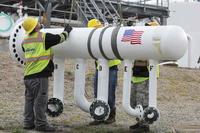The Department of Defense will expand its investigation into the prevalence of "forever chemicals" in base drinking water systems and neighboring water supplies following the Environmental Protection Agency's publication of stricter standards for the synthetic substances.
The EPA announced Wednesday new national limits for six types of per- and polyfluoroalkyl substances, or PFAS, in drinking water supplies. Many of these chemicals have been used extensively on military installations in firefighting foams, industrial solvents, non-stick coatings and other products, causing widespread contamination of groundwater, soil and adjacent communities.
Since 2016, the Defense Department has conducted assessments or investigated the use of PFAS and related contamination at 715 active and former military installations, National Guard facilities and other closed defense sites.
Read Next: Unsupervised: Military Child Care Centers Slow to Report Abuse with Little Oversight
As of December, the DoD had completed assessments of 707 installations, finding that 574 needed to proceed to the next step of the cleanup process, while no further action was required at 133 installations.
The stricter standards may mean, however, that some sites considered to need no or limited remediation may require more attention.
The Defense Department has used firefighting foams containing certain types of PFAS chemicals for more than 50 years. Many DoD sites determined to be contaminated have high levels of perfluorooctane sulfonate, or PFOS, and perfluorooctanoic acid, or PFOA, in drinking water above the EPA's former lifetime recommendation of 70 parts per trillion.
The EPA's new standard drops the contamination standard for PFOA and PFOS to 4 parts per trillion each, a change that a DoD official said the department has been preparing for.
In an email to Military.com, Pentagon spokesman Robert Ditchey said the department, in anticipation of the tighter restrictions, reviewed existing samples taken from on-base water supplies to determine whether levels met the new standards and will expand cleanup investigations in neighboring communities to do the same.
The DoD plans to provide drinking water treatment for wells off base that don't meet the new standards and also will develop cleanup plans for those sites within a five-year timeframe set by the EPA, Ditchey added.
"The department supports EPA's development of a nationwide drinking water standard for PFAS that applies to everyone," Ditchey wrote. "DoD has been preparing to implement the final rule for both our on-base DoD drinking water systems and within our cleanup program."
A federal study of U.S. military firefighters published last year showed a direct link between PFAS chemicals and testicular cancer, and the chemicals also have been tied to kidney cancer.
PFAS chemicals also have been linked to certain other types of cancer, increased cholesterol, high blood pressure in pregnant women, lower birth weights and decreased immune response to vaccines.
EPA officials estimate that the federal rule will reduce PFAS exposure in drinking water for about 100 million people. When the announcement was made, environmental advocates praised the move -- the first time in nearly 30 years the EPA has added a standard for new contaminants.
"Today, we can celebrate a huge -- and long overdue -- victory for public health in this country," Robert Bilott, a Cincinnati-based environmental attorney who has represented members of class-action suits against chemical manufacturers DuPont and 3M, said in a statement.
"The U.S. EPA is finally moving forward to protect drinking water across the United States by adopting federally enforceable limits on some of the most toxic, persistent and bioaccumulative chemicals ever found in our nation's drinking water supply," Bilott added.
The Pentagon announced last year it would stop buying firefighting foams containing PFAS chemicals and halt their use altogether by the end of 2024. While the services have largely phased out the use of aqueous film forming foams containing PFAS for training, the chemicals are still used to fight fires on ships and submarines and in aircraft hangars and locations such as fuel farms, since an effective substitute has yet to be developed.
There are thousands of different types of PFAS compounds, known as "forever chemicals" because they are difficult to destroy and don't break down naturally in the environment.
They accumulate in the bloodstream and soft tissue of the human body, and nearly every American has some level of contamination.
The new EPA rules also set individual limits for three other compounds -- PFHxS, PFNA and GenX -- of 10 parts per trillion and institute a "hazard index," or recommended threshold, for those chemicals when combined with the PFAS compound PFBS.
According to Ditchey, the DoD expects that, after it reexamines drinking water supplies or after its ongoing community testing and cleanup, "a significant number of additional wells will require treatment."
"DoD will first prioritize locations where known levels of PFAS in drinking water from DoD activities are the highest. To expedite implementation of more enduring solutions, the DoD will focus on installing treatment systems, such as whole house filters," Ditchey said.
The Pentagon has requested $1.6 billion in its fiscal 2025 budget for PFAS cleanup of contaminated sites. The funding is $100 million more than the department's fiscal 2024 request.
The DoD maintains a website that provides information about its efforts to investigate and clean up contamination related to military activities.
Related: US Military Says National Security Depends on 'Forever Chemicals'












